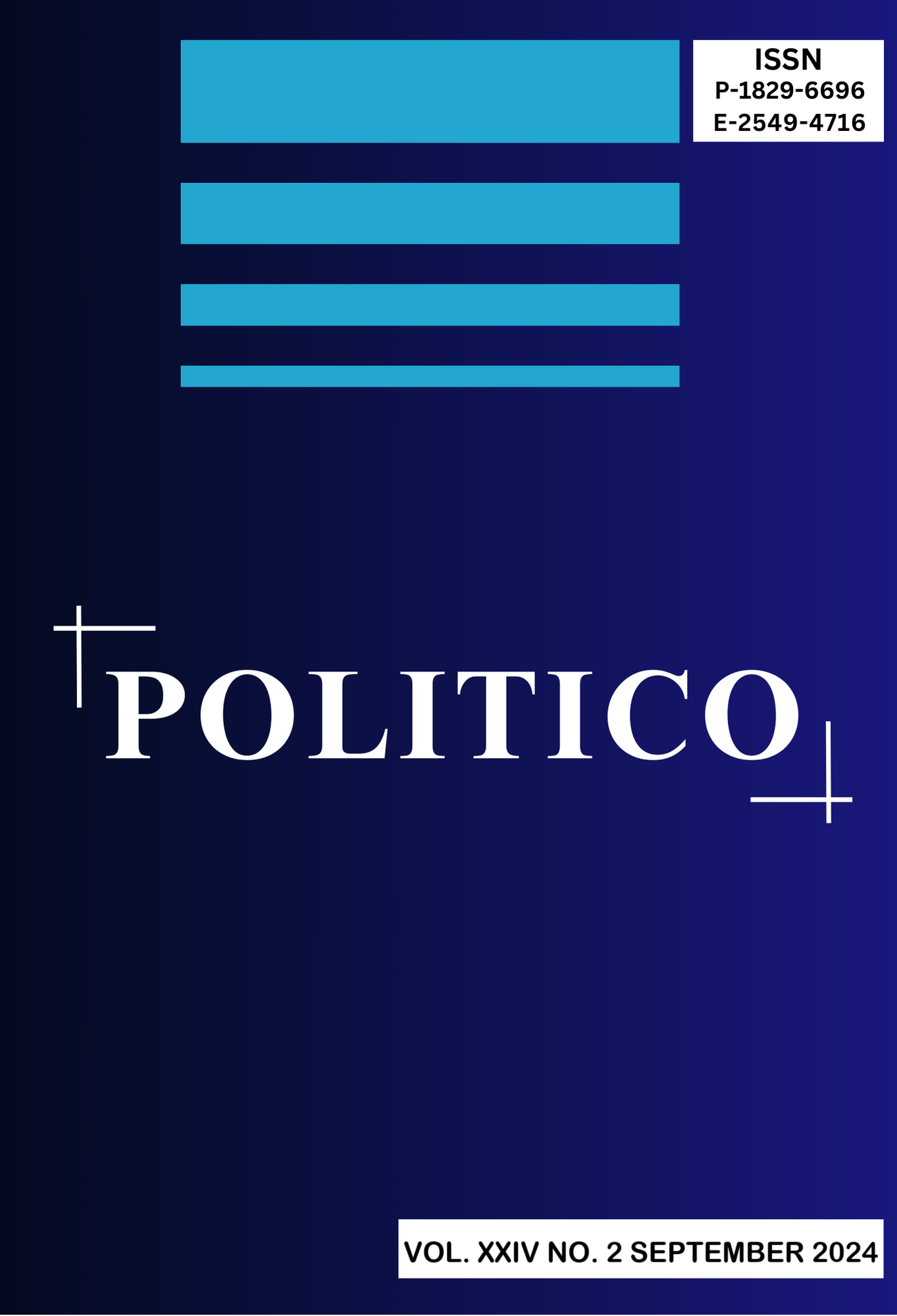The Effectiveness Of The Palermo Protocol In The Case Of Women And Children: Countering Human Trafficking In The Philippines
DOI:
https://doi.org/10.32528/politico.v24i2.3050Keywords:
Human trafficking, Palermo Protocol, Philippines, Domestic SalienceAbstract
Human trafficking, particularly involving women and children, is a serious challenge for the Philippines. As a country with a high rate of child sexual exploitation in East Asia, the Philippines has sought to eradicate this crime through the ratification of the Palermo Protocol, the passage of Republic Act No. 9208 and Republic Act No. 10364, as well as the establishment of the Inter-Agency Council Against Trafficking (IACAT). This study analyzes the effectiveness of the implementation of the Palermo Protocol in the Philippines using the Domestic Salience theory to measure the extent to which international norms have been adopted in domestic policies. The results show that the Philippines successfully improved its law enforcement capacity and obtained Tier 1 status in the Trafficking Victims Protection Act (TVPA) in 2016. However, challenges such as limited resources, corruption, and inter-agency coordination still hinder the effectiveness of anti-trafficking policies. With a national strategy that includes prevention, victim protection, law enforcement, and international partnerships, the Philippines continues to reduce human trafficking. Despite significant progress, the study concludes that policy strengthening through cross-sector coordination, capacity building of law enforcement officials, and expansion of victim rehabilitation services are needed to ensure long-term effectiveness in combating human trafficking.
References
106th Congress. (2000). Victims of Trafficking and Violence Protection Act. Public Law 106-386, 1–86. http://thomas.loc.gov/cgi-bin/query/z?c106:H.R.3244.ENR:
Committee, I.-A. E. (2002). A Strategic Action Plan For a National Coalition Against Trafficking Human Beings. https://www.unodc.org/pdf/crime/trafficking/strategic_compresd2.pdf
Cortell, A. P., & Davis, J. W. (2000). of Agenda. International Studies, 2(1), 65–87.
Department of Justice. (2003). Inter-Agency Council Againts Trafficking. https://www.doj.gov.ph/iacat_webpage.html
Gajic-Veljanoski, O., & Stewart, D. E. (2007). Women Trafficked Into Prostitution: DeterminantS, Human Rights and Health Needs. Transcultural Psychiatry, 44(3), 338–358. https://doi.org/10.1177/1363461507081635
Hapsari, Dina Laksita, D. (2024). Sang Pencerah - Sang Pencerah. Sang Pencerah: Jurnal Ilmiah Universitas Muhammadiyah, 10, 475. https://doi.org/https://doi.org/10.35326/pencerah.v10i2.5307
IACAT. (2003a). Amended Rules and Regulations Implementing. 9136, 1–30.
IACAT. (2003b). History of IACAT. https://iacat.gov.ph/?page_id=63
IACAT Secretariat. (2016). ACCOMPLISHMENT REPORT For the reporting period : CY 2016. 1–52. https://iacat.gov.ph/?p=6008
Inter-agency Council Against Traficking. (2011). the Second National Strategic Action Plan Against Trafficking in Persons 2012-2016. 32.
International Labor Organization, & Walk Free Foundation. (2017). Global Estimates of Modern Slavery: Forced Labour and Forced Marriage. http://www.ilo.org/wcmsp5/groups/public/---dgreports/---dcomm/documents/publication/wcms_575479.pdf
International, W. H. (2021). Addresing OSEC with Research & Action. https://worldhope.org/project/osec-research-and-response/
Koeswindrya, R. (2020). Analisa Upaya Filipina Mengatasi Perdagangan Manusia Melalui Pendekatan Human Security (2016-2019) [Universitas Airlangga]. https://repository.unair.ac.id/100799/
Mindanaoan Irene. (2011, July 25). Full Text President Noynoy Aquino SONA 2011. https://mindanaoan.com/2011/07/full-text-president-noynoy-aquino-sona-2011/
Ramdhan, M. (2021). Metode Penelitian (A. A. Effendy (ed.)). Cipta Media Nusantara. https://books.google.co.id/books?hl=en&lr=&id=Ntw_EAAAQBAJ&oi=fnd&pg=PR1&dq=metode+penelitian+deskriptif+menurut+para+ahli&ots=f3oE8QTx6v&sig=MPr_AZr_OSD9-q9Ofxl-o9fNlPI&redir_esc=y#v=onepage&q&f=false
Romero, A. (2022). Determinants Anti-Trafficking Efforts. 9. https://www.biicl.org/documents/11415_philippines.pdf
Shahrullah, R. S., & Tjhang, D. F. (2014). Tinjauan Yuridis Terhadap Penanggulangan Tindak Pidana Perdagangan Manusia di Indonesia dan Filipina. Journal of Judicial Review, 16(1), 120–133. https://journal.uib.ac.id/index.php/jjr/article/view/143
Shelley, L. (2012). The Relationship of Drug and Human Trafficking: A Global Perspective. European Journal on Criminal Policy and Research, 18(3), 241–253. https://doi.org/10.1007/s10610-012-9175-1
Syaufi Ahmad. (2011). Tindakan Pidana Perdagangan Orang. Muwâzâh, 3(2), 43.
U.S. State Department. (2016). Office To Monitor and Combat Trafficking in Persons 2016 Trafficking in Persons Report. https://2009-2017.state.gov/j/tip/rls/tiprpt/countries/2016/258843.htm
Umar, H., & Kusumadewi, C. J. (2021). Konvensi Pbb Tentang Human Trafficking: Eksploitasi Seksual Perempuan Di Filipina Tahun 2016 – 2019. Jurnal Ilmu Dan Budaya, 42(2), 306. https://doi.org/10.47313/jib.v42i2.1452
UNODC. (2003). Coalitions against Trafficking in Human Beings in the Philippines. www.unodc.org
UNODC. (2016). Global Report on Trafficking in Persons - 2016. In Global Report on Trafficking in Persons (Vol. 2016). http://www.unodc.org/unodc/data-and-analysis/glotip.html%0Apapers3://publication/uuid/CB8EC5EE-D2DA-4509-9C70-513E72588358
USA. (2016). Trafficking In Persons Report June 2016.
Wilujeng, D. I. (2016). Studi Komparasi Hukum Pidana Indonesia Dan Filipina Tentang Perdagangan Orang (Trafficking In Persons) [Universitas Islam Indonesia]. Https://Dspace.Uii.Ac.Id/Bitstream/Handle/123456789/9133/Tesis Magister Hukum Uii 2017-Dwi Indah Wilujeng.pdf?sequence=1
Yudhatama, A. (2022). Implementasi Protokol Palermo Pada Kasus Human Trafficking Di Malaysia Tahun 2015-2018 [Universitas Pembangunan Nasional “Veteran” Jawa Timur]. https://repository.upnjatim.ac.id/10765/
Downloads
Published
How to Cite
Issue
Section
License
Copyright (c) 2024 POLITICO

This work is licensed under a Creative Commons Attribution-ShareAlike 4.0 International License.










